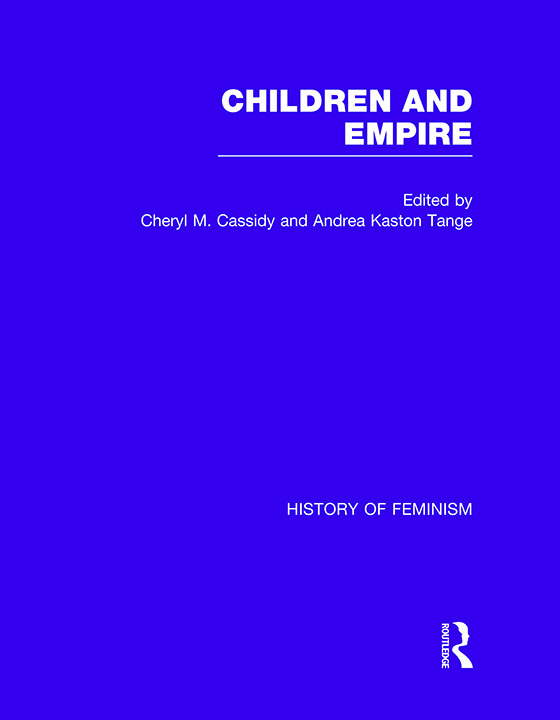Access to the full content is only available to members of institutions that have purchased access. If you belong to such an institution, please log in or find out more about how to order.
Loading content
We were unable to load the content

Children and Empire
- Edited by
- Cheryl M. Cassidy
- Andrea Kaston Tange
- Published: 14 Dec 2012
- DOI: 10.4324/9780415578370
- Set ISBN: 978-0-41557-837-0
The History of Feminism series makes key archival source material readily available to scholars, researchers, and students of women’s and gender studies, women’s history, and women’s writing, as well as those working in allied and related fields. Selected and introduced by expert editors, the gathered materials are reproduced in facsimile, giving users a strong sense of immediacy to the texts and permitting citation to the original pagination. Building on the success of Women and Empire (2009), this new title in the series brings together in four volumes a unique range of nineteenth-century texts on children and empire.
Making readily available materials which are currently very difficult for scholars, researchers, and students across the globe to locate and use, Children and Empire is a veritable treasure-trove. The gathered works are reproduced in facsimile, giving users a strong sense of immediacy to the texts and permitting citation to the original pagination. Each volume is also supplemented by substantial introductions, newly written by the editors, which contextualize the material. And with a detailed appendix providing data on the books, newspapers, and periodicals in which the gathered materials were originally published, the collection is destined to be welcomed as a vital reference and research resource.
Set Contents
In 1893, a young American Negro missionary named Nancy Jones wrote to her missionary friends at home about her life in a remote missionary station in Africa (“Letter” 347). As a Negro missionary, in a time when memories of slavery were still present in the public consciousness, Nancy Jones was unusual in the ranks of young women sent to evangelize women and children for the American Protestant women’s foreign missionary movement. Yet, Jones was typical of young American missionary women who saw missionary work overseas as a way to combine a professional life with spiritual endeavor. Throughout the nineteenth century and well into the twentieth century, hundreds of young American and British women were sent from Protestant denominational societies to evangelize heathens overseas. From Argentina to Japan, young American and British women founded hospitals, schools, and missionary posts to elevate heathen women and children to Western standards. Their focus on children was instrumental in promoting both an evangelical and an imperialistic imperative.
Popular discussion of children in America and Britain in the nineteenth century reflected the growing notion that childhood was a time to be savored, protected, and sheltered, and included a burgeoning discourse on how to manage children at home and abroad. From medical professionals such as Pye Henry Chavasse, whose influential books in the latter decades of the nineteenth century told generations of mothers what to expect during their children’s youth, to novelists whose characters expounded their views on mothering, to the rise in patent foods advertised for the very young, everyone seemed to have an opinion about the proper management of children. This volume will include the rearing of children, especially establishing Western tenets for children in colonial settings. For example, Christina Bremner’s accounts of Anglo-Indian children in the Punjab not only examine images of English children in India, but present a skewed portrait of English children at home. Excerpts from Pandita Ramabai and others discuss the tragic plight of child brides and child widows in India. The texts included in this volume outline customs surrounding childhood, whether exotic or distasteful, and reflect the distress at inappropriate feeding and clothing of native children encountered by travelers, as well as discussions of infanticide and the problems colonial settlers encountered when adapting their fragile children to unfamiliar climates (for example Thurston). Yet discussion also centered on domestic pastimes for children and debated how to combat disease as well as how to rear and discipline children.
The nineteenth century witnessed unprecedented movements of people around the globe. While exploration and colonial expansion were not new, they reached their height in the last quarter of the century, when British colonial rule extended throughout the world. The notion that the sun never set on the British Empire was visually reinforced in maps of the period, on which British dominions were colored pink or red and occupied some portion of every habitable continent. Meanwhile, the United States, which not long before had been a British colony, became in its own right a colonial power, through the slave trade, the gradual, forcible acquisition of Native American lands, and incursions into the Pacific as well as into Spanish colonies such as the Philippines.
The Children and Empire collection is predicated on the notion that imperial progress and nineteenth-century childhood were deeply interdependent. As our first three volumes have shown, building strong empires required not only military force and political conquest; it also necessitated carefully managing children’s lives around the world in order to ensure the successful spread of British and American cultural norms. At their most basic, colonial endeavors attempted to establish habitable, familiar domestic spaces in new locales. Because children were taken as a vital marker of the success of domestic establishments, imperial efforts frequently sought to impose British and American narratives of childhood onto the people of other cultures.